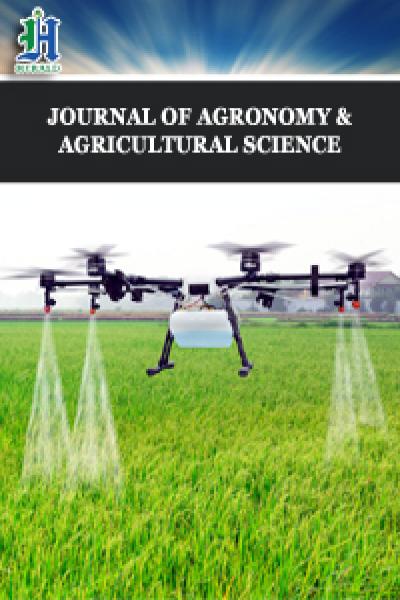
Development of Irrigation Regime of Limited and Unlimited Water Supply for Satisfactory Rice Yield
*Corresponding Author(s):
Dillip Kumar SwainDepartment Of Agricultural And Food Engineering, Indian Institute Of Technology, Kharagpur, India
Tel:+91 9933023760,
Email:swain@agfe.iitkgp.ac.in
Abstract
Rice is the staple food for majority of the population worldwide and is a water-consuming crop. Decreasing water availability due to climate change necessitates the development of water saving rice production technology. The objective of this study was to develop water management strategies for two contrast scenarios of water availability for improvement of rice yield with high water productivity. A pot experiment using different levels of water percentages for water management treatments in rice was conducted inside a greenhouse during the wet
season of 2018 and 2019 in the research farm of Agricultural and Food Engineering Department of Indian Institute of Technology Kharagpur, India. The water management treatments were flooded (+5 cm water depth was maintained), saturated, and irrigation at 0.4, 0.6, and 0.8 bar soil water tension (water applied up to saturation whenever the soil moisture reached the specified level (0.4, 0.6, and 0.8 bar in 0-20 cm soil depth)). Under limited water availability, irrigation at 0.6 bar gave statistically comparable yield as in saturation (0 bar),
While saving 28% water with 8% higher water productivity. Further increasing the water stress up to 0.8 bar gave significantly lower yield (54%) than saturation level. Under non-limited water availability, the yield of saturation was comparable with flood irrigation while saving 27% irrigation water.
Keywords
Limited water; Rice yield; Soil water tension; Water productivity; Water stress
INTRODUCTION
The global population is expected to reach between 8.4 and 8.6 billion by 2030 and between 9.5 and 13.3 billion in 2100 [1]. With the increasing population, global food demand is expected to be 555 million tons by 2030 from 439 million tons in 2010 [2]. The increasing demand for food production has become a great challenge due to decreasing water availability for future agricultural production. Over the last century, global water withdrawal grew 1.7 times faster than the population, which aggravates the concern over the sustainability of water use as demand for agricultural, industrial, and domestic uses continues to increase. Agriculture is the largest water user worldwide, accounting for 70 percent of total freshwater withdrawals on average [3], but these amounts can reach as much as 95 percent in some developing countries [4] Moreover, climate change poses a serious threat to the availability of water resources in future scenarios, which is a major concern for high (>1000mm) water-consuming crops. Rice is one of the largest consumers of freshwater resources, as it is grown under flooded or submerged condition. It is the staple food for half of the world population and the most important cereal in India accounting for 41% of the total food grain production of the country [5]. The water requirement of puddle transplanted rice crop is 475-2500 mm with low nitrogen use efficiency of 30-40% . Over 80% depletion of freshwater in Asian countries is due to irrigated systems used in agriculture, and most of which is used for irrigating rice crop [6]. In order to maintain the food security with declining water resources globally, efforts should be made to decrease the overuse of inputs and promote the use of innovative water-saving rice production technologies to conserve soil moisture while maintaining optimum yield. Rice establishment techniques to actively save irrigation water were probed over the years and included dry seeding, keeping the soil at saturation, and keeping soil alternately submerged or non-submerged. Researchers had found that aerobic fields (irrigated when the soil water potential at 15-cm depth reached 30 kPa) resulted in 15-39% lower yield, and 36-41% lower irrigation water use as compared with flooded conditions [7]. Alternate wetting and drying irrigation (AWD), which is a method of irrigation where water is allowed to dry before the next irrigation, can significantly reduce the amount of irrigation water input by as such as 35% without yield penalty [8]. AWD is a promising, water-saving, economically viable, and eco-friendly alternative to conventional flooding, and reported 25-70% less water requirement than conventional system without yield reduction [9]. Researchers reported lowest water use in rice under severe AWD (when soil dried beyond -20 kPa); under mild AWD (i.e., when soil water potential was ≥ -20 kPa or field water level did not drop below 15 cm from the soil surface), water use was reduced by 23.4% relative to conventional flooding [10]. In past years, various types of water-saving rice production technologies have been tested but there is a lack of information regarding water management strategies under different water availability situations for proper management and sustainable utilization of water resources. With regards to varying water resources due to climate change, it is important to know the effect of limited and excess water on the rice crop to get an understanding of maintaining optimum yield in case of extreme situations. The present investigation was performed to evaluate the effect of different water stress and flood irrigation on grain yield and water productivity of rice. The objective of the investigation was to develop water management strategies for two contrast scenarios of excess (non-limited) and limited water situations and to study its effect on rice yield and water productivity for efficient use of resources.
MATERIALS AND METHODS
Experimental site
The experimental site is located in the Agricultural and Food Engineering Department, Indian Institute of Technology, Kharagpur, India, with latitude and longitude of 22°19´ N and 87°19´ E, respectively. The experiment was carried out in pots (height-30 cm and diameter-11.25 cm) inside a greenhouse, during the wet season (June-October) of 2018 and 2019. The soil of the experimental site is red lateritic with sandy loam texture.
Experimental methodology
The experiment included five water management treatments as flooded (+5 cm of water depth was maintained during the growing period; Flood), saturated (soil was kept at saturation; 0 bar), and irrigation at 0.4, 0.6, and 0.8 bar soil water tension (water was applied up to saturation whenever the soil moisture reached at 0.4 bar, 0.6 bar or 0.8 bar soil water tension in 0-20 cm depth) in two replications for each year. Each pot had a dimension of 11.25 cm diameter and 30 cm height, with 12 kg of soil. Before planting rice seedling, the top soil (0-20 cm) in each pot was well mixed with water to mimic puddling as in normal field operation. Rice seedlings of 25 days old of selected variety (Sourabh NP 950) were transplanted in the pots (2 hills perpot) on 25 July in 2018 and on 26 July in 2019. The normal dose of chemical fertilizer used for the pot was 120, 50, and 60 kg ha-1 of N, P2O5, and K2O [2]. The source of fertilizer for the N, P, and K were urea, single super phosphate, and murate of potash, respectively. As per the dose, the quantity of fertilizer applied in each pot was 1.56g urea, 1.86g single super phosphate, and 0.636g murate of potash. The N requirement was fulfilled by applying the urea in three splits (20%, 40%, and 40%) at basal, active tillering, and panicle initiation stages. The fertilizer doses of P2O5 and K2O were applied as basal before transplanting.
Crop observations
Plants from each pot were harvested at maturity to calculate the above ground biomass. Grain yield and yield components such as panicles per pot, filled grains per panicle, filled grains per pot and filled grain percentage were recorded at maturity.
Water input and productivity
Tensiometers [11], were installed in all the pots, except flooded treatment for monitoring soil water tension and to irrigate as per the treatment. A soil moisture characteristic curve was developed, and based on the curve, the irrigation was scheduled. The irrigation was given when the soil moisture tension in top soil (0-20 cm depth) reached the specified value (0.4, 0.6, and 0.8 bar) as per the treatment. For the treatment of 0 bar and flooding, irrigation was given regularly to maintain saturation and water height (+5 cm), respectively throughout the crop growth. The total amount of water applied was calculated at the end of the season for all the treatments. Water productivity for each treatment was calculated as
WP = Y / WR
where, WP is water productivity (g/L), Y is grain yield (g/pot), and WR is the total amount of water applied (L/pot) [2].
Statistical analysis
Data were collected for the two-year experiments and analyzed statistically. The significance of the treatments was tested by analysis of variance (ANOVA), and differences between treatment means were compared by using the least significant difference (LSD) at p=0.05. The computation was done by using the ‘agricolae’ package (five water management levels and four replications) for the ‘LSD.test’ function of R software version 3.6.2 [12].
RESULTS AND DISCUSSION
Above ground biomass, yield components, and grain yield
Averaged over two years, increasing soil water tension up to 0.8 bar over saturation (0 bar) decreased the above ground biomass up to 30% (Figure 1). The stress irrigation treatments (0.4,0.6, and 0.8 bar) decreased biomass by 33-43% (significantly at p=0.05) as compared to flooding treatment. Reduction in soil moisture levels may cause a fewer number of leaves and smaller size leaves, which might be due to inhibition of the photosynthesis and cell division of meristematic tissue under water stress conditions [13]. The irrigation treatment did not influence the number of panicles per pot significantly, and the value was in the range of 14 to 16 among the treatments. The filled grains per panicle was maximum (156 grains) in flood irrigation, which decreased significantly in saturation (115 grains) and rest stress irrigation treatments. It has been reported by many researchers that rice crops suffered by increased sterility under water stress [14,15]. Decreased filled grains per panicle under lower soil moisture levels might be due to inhibition of translocation of assimilate to the grains due to moisture stress [13]. The response of filled grains per pot to the irrigation treatments was similar to the filled grains per panicle. The saturation (0 bar) treatment gave 31% lower filled grains per pot than the flood, but this was comparable with 0.4 and 0.6 bar. The 0.8 bar treatment showed 50% lower filled grains per pot as compared to 0 bar. The filled grain percentage varied from 52-73% among different stress irrigation treatments (0 to 0.8 bar) and was 85% for flood irrigation. Increasing stress up to 0.6 bar over 0 bar showed similar filled grain percentage, but further stress of 0.8 bar resulted in a significant decrease in the grain filling. Severe water stress conditions may cause inactivation of pollen grains and incomplete pollen tube development, which might affect the number of filled and unfilled grains. When drought occurred during the grain filling stage, the percentage of filled grains decreased to 40% [16]. The maximum grain yield of 67 g/pot was noted in flood irrigation, which was comparable with saturation (57g/pot), but 32-34% significantly higher than stress irrigation (0.4 and 0.6 bar) treatments. Our results indicated that increasing stress up to 0.4 bar and 0.6 bar decreased the grain yield by 20% and 22%, respectively, as compared to the yield of saturation (0 bar), but they were statistically comparable. The stress irrigation (0.8 bar) gave significantly lower grain yield as compared to the saturation treatment, and the yield reduction was 54%. It has been reported that water deficit during vegetative growth did not significantly reduce grain yield, whereas water deficit imposed during the reproductive (flowering) period reduced grain yield to 20- 70% of the irrigated control [17].In our study, the yield was not much affected in 0.4 bar and 0.6 bar stress, but 0.8 bar showed severe reduction due to water stress around panicle initiation and flowering stages when compared with no stress or saturation condition. During the tillering stage, both 0.6 bar and 0.8 bar soil water tension were not achieved by the plant, but 0.6 bar showed comparable yield with saturation, and contrary to this, 0.8 bar showed 54% significantly lower yield. It implies that rice has tolerance to the water stress during the early growth phases (tillering), but in later stages (reproductive), the stress beyond 0.6 bar gave significantly lower yield when compared with no stress irrigation. 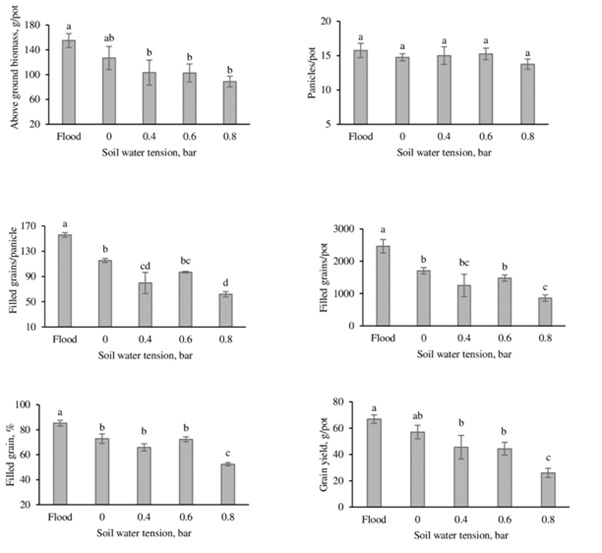 Figure1: Effect of irrigation application at different soil water tension and flood depth on biomass, yield components, and grain yield of rice. Different lower-case letters denote a significant difference (p < 0.05) based on LSD (p=0.05) as averaged over two years.
Figure1: Effect of irrigation application at different soil water tension and flood depth on biomass, yield components, and grain yield of rice. Different lower-case letters denote a significant difference (p < 0.05) based on LSD (p=0.05) as averaged over two years.
Water input in growth stages
As averaged over two years (2018 and 2019), the total amount of water applied for flooding, 0 bar, 0.4 bar, 0.6 bar, and 0.8 bar irrigation treatments were 1013 mm (10.06 L), 742 mm (7.37 L), 615 mm (6.11 L), 537 mm (5.34 L), and 502 mm (4.99 L), respectively (Figure 2). An equal amount of irrigation was applied at transplanting in all the treatments in both the years. The total water applied during transplanting (TP) to active tillering (AT), AT to panicle initiation (PI), PI to flowering (FL), and FL to maturity (MT) stages were 49, 22, 15, and 14% of the total irrigation, respectively in flood treatment and 44, 26, 15, and 16% of the total irrigation in saturation. For the stress irrigation treatments (0.4 and 0.6 bars) having comparable yield with saturation, the water application in corresponding growth stages were 45, 19, 19, and 17% in 0.4 bar, and 42, 24, 18, and 17% in 0.6 bar and for the 0.8 bar irrigation, the corresponding values were 45, 13, 25, and 17%. The saturation treatment saved 27% irrigation water as compared to flood irrigation with the maintenance of a similar yield. The stress irrigation treatments resulted in water savings of 17% in 0.4 bar and 28% in 0.6 bar as compared to 0 bar, without sacrificing the grain yield. Rice under AWD reported 31% irrigation water saving compared with conventional flooding with a similar yield over two years [18]. In flooded conditions, a higher amount of water was used, as standing water was maintained during the growing season. Increasing soil water tension from 0.4 bar to 0.8 bar decreased the yield by 32-61% as compared with flood treatment. It has also been reported in previous studies that when soil water potentials in the root zone were allowed to reach -100 to -300 mbar, yields were reduced by 10-40% [19]. However, water savings at the cost of sacrificing a significant amount of rice yield is not acceptable, as yield is the most important factor for the farming community. Overall, our result indicated that the stress irrigation up to 0.6 bar could save 28% irrigation water with no significant yield reduction as compared to 0 bar, but further increasing stress to 0.8 bar resulted in 32% water savings at the cost of 54%reduction in yield. Researchers have found that rice yield of both direct-seeded and puddle transplanted rice production systems declined under higher water deficit stress (40 and 70 kPa irrigation thresholds) but was similar at 20 kPa [20]. It implies that rice crop can tolerate mild stress up to a certain limit without affecting the yield, but severe stress significantly reduces the yield.
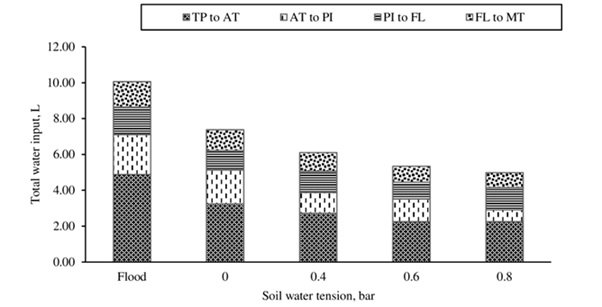
Figure 2: Total amount of water applied from the day of transplanting at different growth stages of rice for different soil water tension and flood depth as averaged over 2018 and 2019.
Note: TP-Transplanting, AT- Active Tillering, PI- Panicle Initiation, FL- Flowering, MT- maturity.
Concerning the maintenance of the soil water tension below the specified value, the irrigation was applied at different growth stages of the crop as per the treatment (Figure 3). As averaged over two years, the total number of irrigations applied after TP to MT of the crop were 30, 26,10, 8, and 6 for flooding, 0 bar, 0.4 bar, 0.6 bar, and 0.8 bar treatments, respectively (Figure 4). During TP to AT; 6, 7, and 1 irrigation were given for flood, 0 bar, and 0.4 bar treatments; whereas no irrigation was given for 0.6 and 0.8 bar treatments. However, during AT to PI, three irrigations were provided for 0.4 bar and 0.6 bar, but two irrigation was used for 0.8 bar. During the PI to FL, the number of irrigations in all stress irrigations (0.4, 0.6, and 0.8 bar) remained the same, whereas in post flowering, more number of irrigation was used for 0.4 and 0.6 bars as compared to 0.8 bar. The crop for the irrigation treatment 0.8 bar suffered due to lack of water around PI and FL stages, as the most sensitive stages for N and water inputs, hence gave significantly lower yield.
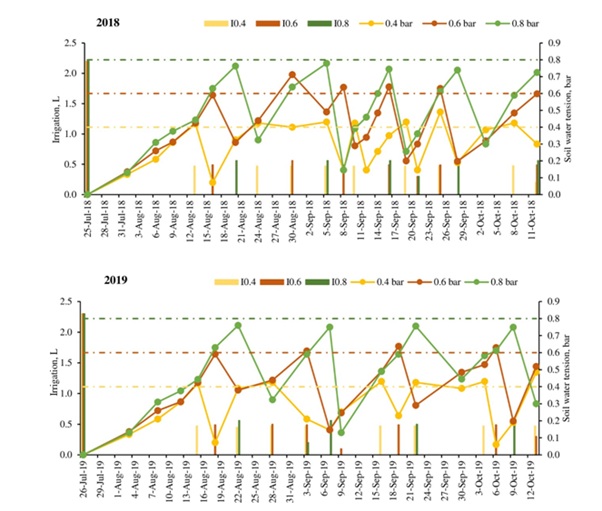 Figure 3: Irrigation application for different stress irrigation treatments (0.4, 0.6, and 0.8 bar) throughout the growing season of rice for the year 2018 and 2019.
Figure 3: Irrigation application for different stress irrigation treatments (0.4, 0.6, and 0.8 bar) throughout the growing season of rice for the year 2018 and 2019.
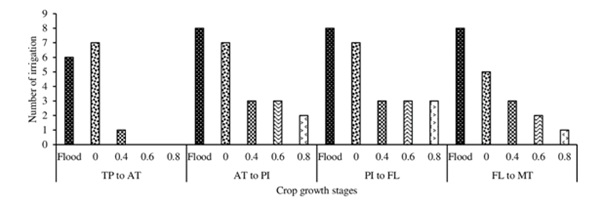 Figure 4: Number of irrigations after transplanting in different crop growth stages of rice for different soil water tension and flood depth as averaged over 2018 and 2019.
Figure 4: Number of irrigations after transplanting in different crop growth stages of rice for different soil water tension and flood depth as averaged over 2018 and 2019.
Note: (TP-transplanting, AT- active tillering, PI- panicle initiation, FL- flowering, MT- maturity)
Water productivity
Averaged over the two years, the water productivity of rice for all the treatments varied from5.3 to 8.36 g/L (Figure 5). Rice grown under 0 bar, 0.4 bar, and 0.6 bar showed 17%, 13%, and26% higher water productivity than flood treatment, but 0.8 bar recorded 20% lower water productivity. In general, the outflows of water from a rice field are evaporation, transpiration, seepage, percolation, and any over bund flow. Out of these, only transpiration is truly productive water use because it leads directly to rice production. It has been estimated that seepage and percolation account for 50-80% of the total water input to the field [21]. In our study, seepage and percolation losses were restricted, and the only source of water loss was through evaporation and transpiration. The higher water productivity of stress irrigation treatments (0.4 and 0.6 bar) might be due to effective crop water usage and reduction in undesirable losses. Studies reported 36.4% increased water use efficiency under AWD when compared with the local farmers’ practice [22]. In our study, the grain yield of 0.6 bar stress irrigation treatment was found comparable with the yield of 0 bar with less water application. Hence, the water productivity of 0.6 bar was 8% higher as compared to saturation (0 bar). Overall, our result indicated higher water productivity under stress irrigation (0.4 and0.6 bar) over flood irrigation and saturation. [23].
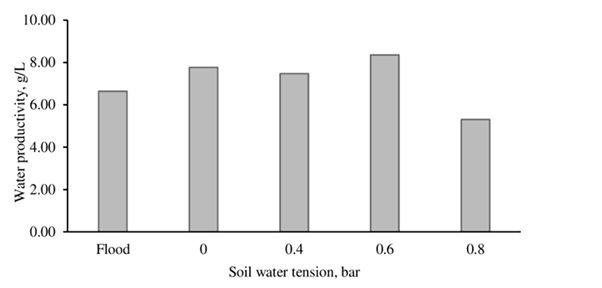 Figure 5: Effect of irrigation application at different soil water tension and flood depth on water productivity of rice as averaged over 2018 and 2019.
Figure 5: Effect of irrigation application at different soil water tension and flood depth on water productivity of rice as averaged over 2018 and 2019.
CONCLUSION
Rice is a water-consuming crop. With the decreasing availability of water for future agricultural production, it is essential to develop and implement water-saving rice production technologies. The present study stated that rice yield under mild stress (up to 0.6 bar) was comparable with saturation, but further increasing stress (0.8 bar) has shown a significant adverse effect on yield components and grain yield. The stress irrigation up to 0.6 bar could save 28% irrigation water with maintenance of similar yield as in saturation. These results concluded that in case of limited water availability, we can go for mild stress up to 0.6 bar, which gave comparable yield as in saturation, while saving irrigation water. However, under sufficient water availability, flooding provided maximum yield and this was comparable with saturation level. Though flooding provided maximum yield, but this will affect the environment through the release of greenhouse gases to the atmosphere. Hence maintenance of saturation level is recommended over flooding system, which could save 27% irrigation water while attaining a similar grain yield of rice. Further research and evaluation under diverse agro-climatic regions may provide location specific water-saving production techniques for yield improvement with efficient use of resources.
ACKNOWLEDGEMENT
The United Nations University, Institute for the Advanced Study of Sustainability, Tokyo, Japan is gratefully acknowledged for providing partial financial support in execution of the field experiment.
DECLARATIONS
Conflicts of interest/Competing interests -The authors declare that they have no conflict of interest. Availability of data and material -All data are fully available without restriction.
CODE AVAILABILITY
Not applicable
FUNDING
The authors received no specific funding for this work.
AUTHORS' CONTRIBUTIONS
Conceptualization: Poonam Biswal, Dillip Kumar Swain, Madan Kumar Jha,; Methodology: All the authors equally contributed; Formal analysis and Investigation: Poonam Biswal, Dillip Kumar Swain; Writing - original draft preparation: Poonam Biswal; Writing - review and editing: Dillip Kumar Swain, Poonam Biswal; Funding acquisition: Geetha Mohan, Hirotaka Matsuda; Resources: Poonam Biswal, Dillip Kumar Swain, Madan Kumar Jha, Geetha Mohan, Hirotaka Matsuda; Supervision: Dillip Kumar Swain, Madan Kumar Jha
REFERENCES
- United Nations Department of Economic and Social Affairs, Population Division (2015). World population prospects: the 2015 revision, key findings and advance tables. Working PaperNo.ESA/P/WP.241.https://esa.un.org/unpd/wpp/Publications/Files/Key_Findings_WPP_2015.pdf
- Rajwade YA, Swain DK, and Tiwari KN (2018) Effect of irrigation method on adaptation capacity of rice to climate change in subtropical India. International Journal of Plant Production 12: 203-217.
- FAO (2011) The state of the world’s land and water resources for food and agriculture (SOLAW): managing systems at risk. Food and Agriculture Organization of the United Nations, Rome and Earthscan, London. http://www.fao.org/docrep/017/i1688e/i1688e.pdf
- FAO (2017) Water for Sustainable Food and Agriculture: A report produced for the G20 Presidency of Germany. Food and Agriculture Organization of the United Nations, Rome. http://www.fao.org/3/a-i7959e.pdf
- FAOSTAT (2016) FAO statistical database. Food and Agriculture Organization of United Nations, Rome. www.fao.org
- Guerra LC, Bhuiyan SI, Tuong TP, and Barker R (1998) Producing more rice with less water from irrigated systems. International Water Management Institute 24: 5-7.
- Belder P, Bouman BAM, Spiertz JHJ, Peng S, Castaneda AR, and Visperas RM (2005) Crop performance, nitrogen and water use in flooded and aerobic rice. Plant and Soil 273, 167-182.
- Cabangon R, Lampayan R, and Bouman BA (2014) Water saving technologies for rice production in the asian region. Environmental Science
- Ishfaq M, Farooq M, Zulfiqar U, Hussain S, Akbar N, et al. (2020) Alternate wetting and drying: A water-saving and ecofriendly rice production system. Agricultural Water Management 241: 106363
- Carrijo DR, Lundy ME, and Linquist BA (2017) Rice yields and water use under alternate wetting and drying irrigation: a meta-analysis. Field Crops Research 203: 173-180 https://doi.org/10.1016/j.fcr.2016.12.002
- Kirkham MB (2005) Principles of soil and plant water relations, Chapter-4, pp. 41-54.https://doi.org/10.1016/B978-0-12-409751-3.X5000-2
- R Core Team (2019) R: A Language and Environment for Statistical Computing. R Foundation for Statistical Computing, Vienna, Austria. https://www.r-project.org
- .Zubaer MA, Chowdhury AKMMB, Islam MZ, Ahmed T and Hasan MA (2007) Effects of water stress on growth and yield attributes of Aman rice genotypes. International Journal of Sustainable Crop Production 2, 25-30
- O’Toole JC and Moya TB (1981) Water deficits and yield in upland rice. Field Crops Research 4, 247-259. https://doi.org/10.1016/0378-4290(81)90076-9
- Rahman MS and Yoshida S (1985) Effect of water stress on grain filling in rice. Soil Science and Plant Nutrition 31(4), 497-511. https://doi.org/10.1080/00380768.1985.10557459
- Boonjung H and Fukai S (1996) Effects of soil water deficit at different growth stages on rice growth and yield under upland conditions. 2. Phenology, biomass production and yield. Field Crops Research 48(1), 47-55. https://doi.org/10.1016/0378-4290(96)00039-1
- Lilley JM and Fukai S (1994) Effect of timing and severity of water deficit on four diverse rice cultivars III. Phenological development, crop growth and grain yield. Field Crops Research 37(3), 225-234. https://doi.org/10.1016/0378-4290(94)90101-5
- Yao F, Huang J, Cui K, Nie L, Xiang J, Liu X, et al. (2012) Agronomic performance of high- yielding rice variety grown under alternate wetting and drying irrigation. Field Crops Research 126, 16-22
- Bouman BAM and Tuong TP (2001) Field water management to save water and increase its productivity in irrigated lowland rice. Agricultural Water Management 49(1), 11-30. https://doi.org/10.1016/S0378-3774(00)00128-1
- Yadav S, Gill G, Humphreys E, Kukal SS, and Walia US (2011) Effect of water management on dry seeded and puddled transplanted rice. Part 1: Crop Performance. Field Crops Research 120, 112-122. https://doi.org/10.1016/j.fcr.2010.09.002
- Sharma PK (1989) Effect of periodic moisture stress on water-use efficiency in wetland rice, Oryza 26, 252-257.
- Xue Y, Duan H, Liu L, Wang Z, Yang J and Zhang J (2013) An improved crop management increases grain yield and nitrogen and water use efficiency in rice. Crop Science 53, 271
- Rajwade YA, Swain DK, Tiwari KN, and Bhadoria PBS (2018) Grain yield, water productivity, and soil nitrogen dynamics in drip irrigated rice under varying nitrogen rates. Agronomy, Soils, and Environmental Quality 110, 868-878. https://doi.org/10.2134/agronj2017.09.0538
Citation: Biswal P, Swain DK, Jha MK, Mohan G, Matsuda H (2021) Development of Irrigation Regime of Limited and Unlimited Water Supply for Satisfactory Rice Yield. J Agron Agri Sci 4: 028
Copyright: © 2021 Poonam Biswal, et al. This is an open-access article distributed under the terms of the Creative Commons Attribution License, which permits unrestricted use, distribution, and reproduction in any medium, provided the original author and source are credited.
